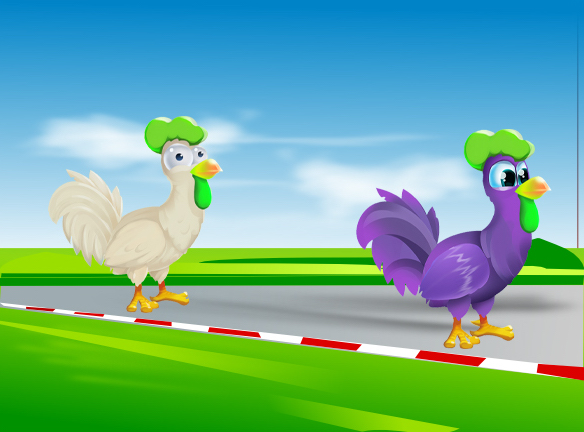
The core element of Chicken Derby is racing so let’s spend some time digging in to what we know about racing and touching on some of the unknown elements that will be at play.
Intro to Racing
Races will consist of 8 chickens (note in some video promos there have been 12 racers) who are all competing to take home the win. You will be able to enter your chicken in to a race either for free or by paying an entry fee. The price of entry will determine the size of the prize pool available should your bird finish in the top 3.
We do not know yet how many different race tracks will exist but there could be as many as 42 different combinations of distances and terrains. There are a total of six different distances available for races: 100m, 120m, 140m, 160m, 180m, or 200m. There are then seven different terrains that can be raced on: Dirt, Grass, Road, Rock, Sand, Snow or Track. It is important to note that each bird will have a distance preference and a terrain preference but this is hidden data. So it will be important to test your bird at a number of different distances and on a wide range of terrains to figure out what the best race is for them. Once you know where a bird is at their strongest it would be wise to continue to race them primarily on that distance and terrain combination.
When you place top 3 in a race you will receive a share of the prize pool. 1st place receives 55% of the pool, 2nd place 30%, and 3rd place 15%. A small portion of the entry fees will also go to the game and be used to fund the prize pool for free races. So its important to note that the ratio of paid races to free races will be heavily in favour of paid so if you are relying on free racing they will likely be less frequent and filled very quickly.
So how do you know if you have a winning chicken?
Well, the simple answer is that you have to race them. And probably race them more than a few times to really know what they are capable of on the race track.
There are some visible indicators of what might make a good racer. These include perfection rating, heritage, stock, and talent but we do not know how each of these will impact racing ability other than the fact that a 100 perfection should beat a 99 perfection most of the time but under the right circumstances the 99 can win.
There will also be some hidden factors that will have to be discovered through racing. These include distance preference, terrain preference, consistency, and even the impact of any cosmetic features. So just because you have a 90 perfection Dorking in your coop doesn’t mean they won’t be a good racer under the right conditions.
The right conditions is where a chicken’s Pecking Order Points will come in to play. With 3 different classes for racing (A, B, and C) it may take some time to ensure your chicken is competing against the right level of competition. Pecking Order Points will go up with strong finishes and down with bad finishes which over time will result in birds moving up or down in class. Not all birds will be capable of competing at Class A or even Class B so keep that in mind if your bird gets off to a slow start on the track. They may just be a Class C racer or you may not have found the right track for them to shine.
The biggest wild-card in racing is going to be talents. Each chicken has their own talent with different rarities and each talent will impact the race in a different way. Until we hit the race track it is hard to say which talent will be the best but we know that in any race we can expect to see 1-2 talents deploying. So when your chicken does get to use their talent it could be a huge edge in making your way to that podium.
Okay so you are probably have one major question now that has not been answered. When can I race my chicken?!?
What we know so far is that the closed beta for racing should begin at some point in early October and the open beta is expected to be available a few weeks after that. With beta sign-ups closed you may have to wait until roughly November to race your chicken but that should give you plenty of time to do your research and craft your own theories about what will matter the most on the race track and what course your bird may perform best on. Its worth spending time digging in to the official tutorial if you haven’t already memorized it (https://bitlovin.gitbook.io/chicken-derby-tutorial/)

